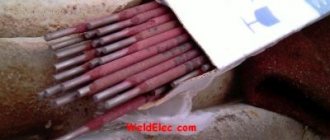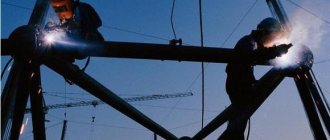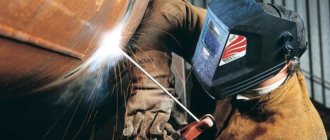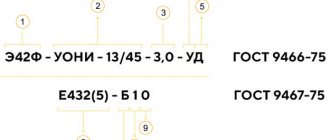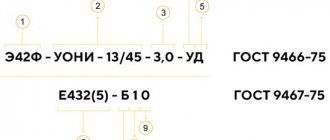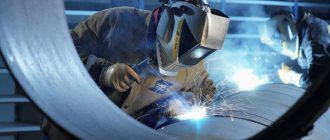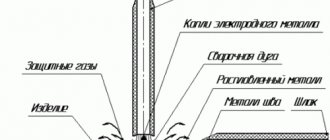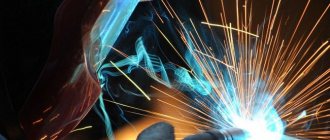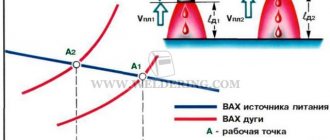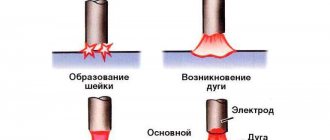Before you start welding metal products, you need to prepare them. The actual preparation of metal for welding consists of several stages. First, the metal is straightened, then the product is marked and cut, cleaned and heated. At the final stage, bending and edge processing are performed. These procedures are necessary in order to achieve high-quality connection of structural elements.
It is worth remembering: rust, metal particles, and other elements remaining on the surface prevent high-quality welding.
Therefore, proper preparation of parts for welding is important, which improves weldability. The number of procedures that must be performed when preparing parts for welding may vary depending on the specific situation - the degree of contamination, deformation of the workpieces, the amount of work, etc. Moreover, all stages of preparation are regulated in accordance with GOST 5264-80.
Edit
During storage and transportation, parts of the future welded joint may lose their shape. Distortions include:
- dents;
- bulging;
- warping;
- waviness;
- curvature.
Correct metal cold and when heated. Corrections of heated metal are easier. Editing can be done either by machine or manually. The machine method is used in industry. It is convenient to carry out manual editing using an anvil. Thick steel or cast iron plates are also suitable.
To carry out the straightening process, it is necessary to prepare a metalworking tool. First of all, you can return it to its original shape using a hammer. However, not just any one will do, but one made of soft material. In some cases, you can even use rubber. The shape of the striker is preferably round - a square one will leave marks on the metal. The surface of the striker must be polished. In addition to a hammer, you can use a wooden or metal smoother.
Convexity and undulation are corrected by hitting the edges and gradually moving towards the center. As you approach the central part, they strike more often, but the force of the strikes is reduced. To adjust thin products, it is advisable to use smoothing bars. The straightening of hardened metal is carried out with a straightened hammer.
Applications of gas welding
Gas welding belongs to the group of fusion welding methods.
A significant technological difference between gas welding and arc welding is smoother and slower heating of the metal. This difference between a welding gas flame and a welding arc, which in some cases is a disadvantage, in others an advantage of a gas flame, determines the main areas of its application: for welding low-carbon, special and tool steels, non-ferrous metals, cast iron, as well as for surfacing work. Due to the versatility, comparative simplicity and portability of the necessary equipment, it is advisable to use gas welding for many types of repair work. The relatively slow heating of metal with a gas flame quickly reduces the productivity of gas welding with increasing metal thickness, and with a thickness of more than 8 ... 10 mm it is usually not economically viable.
With slow heating, a large volume of the base metal adjacent to the weld pool is heated, which, in turn, causes warping of the welded products. This important circumstance makes gas welding technically impractical for such objects as building metal structures, bridges, cars, frames of large machines, etc. Slow heating also causes the metal to remain in a high temperature zone for a long time, which entails overheating, grain coarsening and deterioration mechanical properties of metals. At the same time, slow heating of the metal with a gas flame when repairing cast iron parts reduces the temperature difference, helps remove gases from the metal of the parts and prevents cracking.
Marking
Preparing metal for welding includes bringing the dimensions of the parts into line with those indicated in the drawings. Before you start cutting, you need to mark them. For marking, use a sharp object, chalk, pen, thin felt-tip pen, or pencil. Tools you will also need are a ruler, tape measure, square, and caliper. In large production, templates are used.
In addition to the outline of the parts, the places of bends are marked on the metal part.
cutting
This is one of the most important stages in preparing metal for welding. A metal element cut downwards can be immediately classified as defective. It's good if there is an opportunity to use it for other purposes. It is not very successful if an adjustment of a few millimeters is required, since such a process is quite difficult to carry out.
Cutting Tools:
- metal scissors;
- guillotine;
- Bulgarian.
For thick parts, welding can be used. To do this, you need to melt the part, and then remove the metal so that you get not a seam, but a through hole. If you follow the intended line, you will get a cut, although not too neat. Thermal cutting is applicable for parts of various configurations. Arc welding and oxygen torch are widely used.
Cutting machines are used in industrial production.
Choose the right abrasive profile
There are several abrasive profiles available to you that can make your job easier or more difficult.
Wire wheels are much more resistant to stress, but do not remove the underlying material. This makes them a good choice for removing surface contaminants and coatings without affecting the underlying metal. Abrasives are designed for cutting and removing base metal. Due to the design of the abrasive, heavy coatings and base metal can accumulate between the grains, reducing their cutting ability.
A Type 27 flap disc (flat profile) may produce a significantly different result than a Type 29 (tapered profile). An incorrect profile actually limits the amount of abrasive that comes into contact with the metal surface. Select Type 27 flap discs for lower grinding angles (5 to 10 degrees) and for light pressure applications such as finishing. When sanding at larger angles (15 to 30 degrees), choose a 29-type flap disc, which is more typical for aggressive material removal.
Wire brushes also come in different styles and sizes. Wire gauge and knot type are the most effective performers. Options include stringer, cable and standard twist.
- The stringer brush has knots that are twisted very tightly into a narrow profile. This brush is designed for cleaning tight gaps and initial welds on pipelines and multi-pass welds. They are also commonly used in general manufacturing
- A cable twist brush has a knot that is twisted almost all the way through, with more wire in the knot so it has extra width, stiffness and aggressiveness. This can be significantly more efficient for weld preparation if you don't have to specifically go into a narrow 3mm gap
- The standard twist brush assembly is not twisted all the way to the end, allowing the wire tips to fluff out for increased fit. These brushes are effective on components with a lot of surface, texture or contour imperfections. Inexperienced operators often get the most effective cleaning with a standard twist brush because it covers a wider area and is easier to control.
Stripping
Preparing metal for welding includes cleaning it. Failure to complete this step will result in defects. Even small particles of dirt can cause cracking of the part, the appearance of pores in the structure of the weld, and the emergence of stress spots in the metal.
Cleaning metal surfaces is the easiest preparatory process, but it is very important. You don't need any particularly complex tools. Metal brushes and grinders are used. In production, this process is taken more seriously and shot blasting and sandblasting machines are used.
We should not forget about the need to remove rust, as well as the oxide film, which is formed when the metal comes into contact with atmospheric oxygen. To remove traces of paint and oil stains, a small part can be immersed in a container of solvent. The metal surface must be dried before welding.
Wood cutting
During the preparation of the material, chamfering is carried out. In production, an edge planer is used for this. A gas cutting machine, guillotine or special scissors can also be used. The work is still being done with a chisel. It can be ordinary manual or pneumatic.
Metal cutting is carried out according to risks. Usually they are applied in quantities of 2 pieces. Parallel lines may be used instead. The outer line is always at the bottom of the chamfer. The inner line marks its top edge. If there are no risks, then the worker uses a ruler.
Advice! Before cutting, the sheets must be carefully secured.
Edge preparation
To improve the conditions of the welding process, the edges of the product are processed. This is especially important when welding thick products. Preparation of edges for welding can be done by thermal and chemical methods. The result of processing is the acquisition of a shape that promotes better connection of parts. Grooving increases the width of the seam.
Milling machines, special edge planers, pneumatic chisels, and flame cutting are used in industry. Simpler options are grinding and cutting. For mechanical cutting, metal scissors, a grinder, a chisel, and a file are used. The main parameters are the bevel, cutting angle, gap width, and the amount of bluntness. A bevel is formed when a piece of metal is removed at an angle or rounded.
If welding is performed at an angle, then cutting the edges can be carried out only when the thickness of the parts is more than 3 cm. The presence of a bevel plays an important role when parts of different thicknesses are welded. Sometimes you have to resort to dulling the edges. This is advisable if they have a sharp shape at the end. Otherwise, this may cause the formation of burns, deformation of the seam, the creation of additional stress, and a decrease in the strength of the connection.
The cuts can be on one side only or double-sided. Different types of bevels are used for different connections:
- The one-sided bevel of one or both edges has the shape of the letter “V”. Suitable for use in a wide range of thicknesses. Is the most popular. When cutting both edges, the angle is 60 degrees, and only one - 50.
- The double-sided bevel of both edges resembles the letter "X". Used for products with a thickness of 10-60 mm. Angle - 60 degrees.
- The bevel in the shape of the letter "U" is made on one side. This curved shape is used for metals with a thickness of 20-60 mm. For beginners, the method is difficult.
- A bevel in the shape of the letter “K” is rarely used. In this case, a double-sided bevel is made for one of the edges, and a one-sided bevel for the second.
The designation on the drawings is for the bevel “β” and the opening angle “α”. The bevel should not have any differences. Templates can be used to control cutting.
A separate option is preparing edges for welding pipes. In this process, it is necessary to control the perpendicularity of the end of the pipe to its axis. The requirements are set out in the regulatory document RD 153-34.1-003-01. The total opening angle formed by the two circular edges of both pipes is 60-70 degrees. Blunting is done at a size of 2-2.5 mm.
Preparation of pipes for welding involves gradation according to the wall thickness of the pipes being welded. For small sizes, V- or X-shaped bevels are used. For larger thicknesses, a U-shaped bevel is made.
Preparing pipes for welding also involves discarding. Welding is unacceptable if the difference in the internal diameters of the pipes prepared for welding is more than 3 mm. If the ends have mechanical defects, they are trimmed.
Features of welding seams in various positions
The choice of welding method (right or left) depends on the position of the seam in space. When welding vertical seams from bottom to top, it is more advisable to use the left method (Fig. 15).
In some cases, vertical seams can be welded from bottom to top and in the right way - the so-called through bead (Fig. 16). In this case, the welder burns a through hole in the metal and fills it from below with surfacing on the lower edge. In this case, the edges are not beveled. The parts are assembled with a gap equal to half the thickness of the metal being welded and installed in a vertical position. The seam is formed immediately over the entire thickness of the metal, and a convexity (reinforcement) of the seam is simultaneously formed on both sides of the joint. The weld metal in this case is not inferior in density to the weld welded in the lower position.
Horizontal welds are easier to perform using the right-hand method, in which the gas flow of the flame is directed directly at them and thereby prevents the metal from the weld pool from flowing down. The weld pool is positioned at a certain angle, facilitating the formation of a seam (Fig. 17).
Rice. 15. Scheme of welding a vertical seam from the bottom up (left method) : 1 - filler rod; 2 - burner; 3 - detail; 4 - seam
Rice. 16. Scheme of welding with a through bead : 1 - joint; 2 - filler rod; 3 - burner; 4 - weld pool; 5 - seam; 6 - gas flame
Rice. 17. Welding diagram for a horizontal seam : 1 - filler rod; 2 - detail; 3 - burner; 4 - seam
It is easier to make ceiling seams using the right-hand method, since in this case the end of the filler rod and the pressure of the gas flow prevent the metal from flowing down. Producing such seams using the left-hand method leads to metal leaks and poor-quality bead formation. When ceiling welding, a “softer” flame should be used that does not inflate the metal.
Bending
Preparatory and welding work includes, if necessary, bending of metals. If the parts are in the form of sheets or strips, then sheet bending machines are used. Parts with a profile are bent using special presses.
If it is necessary to bend a small diameter, as well as with a large thickness, then preheating is recommended. This will make the metal more pliable and less effort will be required.
Fixation
Preparing parts for welding includes securing them securely to each other. This will ensure the correct position when welding and prevent them from shifting. A method that guarantees reliable fixation is tack welding. This refers to small seams made across the connection of parts.
The size of their section is limited - it should not exceed half the width of the seam. The length of each tack is no more than 2 cm. Pipeline assembly involves making longer tacks. The distance between them is from 10 to 80 cm depending on the length of the seam. The step size also depends on the thickness of the materials. For short seams, point joints are used at their edges. The height of the tacks should not be too high.
Small seams prevent movement of parts in joints, maintain a constant gap between them and give the structure additional rigidity. This is especially important for large connections. Tacks are performed in one pass.
Tacks are divided into temporary ones, which are removed after the weld is completed, and those that remain. They are performed on the reverse side of the connection. Before starting the process, it is necessary to do the same cleaning of the surfaces as for the main seam.
Welding modes
The welding mode depends on the type of metal being welded, overall dimensions and shape of the product.
The welding method is determined by the thickness of the metal, the position of the seam in space, etc. Depending on the direction of movement of the torch, there are two methods of gas welding. With the left method (Fig. 9, a), which is used most often, the burner flame is directed to the edges of the metal that have not yet been welded, and the filler wire is moved in front of the flame. To uniformly heat and move the weld pool, the torch and wire are given oscillatory movements across the seam so that they move in opposite directions. The left method is advisable to use when welding metals of small thickness (up to 5 mm), as well as metals with a relatively low melting point. This method ensures better formation of the weld metal.
With the right method (Fig. 9, b) the flame is directed to the already welded part of the seam; in this case, the wire is moved in a spiral following the flame, without removing its end from the bath of molten metal. The burner is moved in a straight line. Transverse vibrations are reported to the torch only when welding parts of large thickness.
Rice. 9. Welding methods : a - left; b - right; 1 - filler rod; 2 - gas flame; 3 - seam; 4 - weld pool; 5 - metal to be welded
The use of this welding method increases the productivity of the process while reducing the specific gas consumption due to more complete use of the heat of the flame, and also reduces metal warping due to the high concentration of heat.
The filler wire must match the base metal in mechanical properties and chemical composition. The diameter of the filler wire d depends on the selected welding method and the thickness of the base metal s. For the right-hand welding method d = s/2, for the left-hand welding method d = s/2 + 1 mm.
The determining parameter of gas welding is the number of the torch tip, which provides the required flame power. Depending on the thickness of the metal being welded s, mm, and its thermophysical properties, the flame power is calculated using the formula
M = Cs, (3.1)
where C is the specific gas consumption per 1 mm of the thickness of the metal being welded, dm3/h.
The specific consumption of acetylene and oxygen per 1 mm of thickness of the metal being welded is given in table. 1.
The tip number is selected according to the technical characteristics of the injection burner (GOST 1077 - 79E).
| Table 1. Specific consumption of acetylene and oxygen per 1 mm of metal thickness | |||
| Metal to be welded | Specific consumption per 1 mm of metal thickness, dm3/h | Ratio of acetylene and oxygen | |
| acetylene | oxygen | ||
| Carbon steel | 100 … 130 | 110 … 140 | 1,0 : 1,1 |
| Alloy steel | 75 | 80 … 85 | 1,0 : 1,1 |
| Cast iron | 100 … 120 | 90 … 110 | 1,0 : 0,9 |
| Copper | 150 … 200 | 165 … 220 | 1,0 : 1,1 |
| Brass | 100 … 130 | 135 … 175 | 1,0 : 1,3 |
| Aluminum and its alloys | 75 | 80 … 85 | 1,0 : 1,1 |
| Zinc | 15 … 20 | 20 … 25 | 1,0 : 1,1 |
| Bronze | 70 … 150 | 80 … 165 | 1,0 : 1,1 |
Additional parameters of gas welding that affect the quality and geometric parameters of the weld are welding speed, type of flame, tip angle, distance from the flame core to the bottom of the weld pool.
The welding speed should be changed as necessary, since at a constant welding speed the metal can be overheated or, even worse, overcooked and burnt.
The type of flame also affects the welding mode. During the welding process, a normal flame tends to become oxidizing over time due to the design features of the burners. Excess oxygen in the flame may be undesirable in a particular case, so the welder increases the supply of combustible gas as necessary, keeping his finger on the acetylene valve.
The angle of inclination of the mouthpiece changes depending on the heating of the metal. It can be considered an additional factor to the power of the flame, and based on the shape and size of the weld pool (concave or convex), the welder instantly decides to change the angle. Sometimes, to do this, the welder momentarily draws the flame away from the weld pool.
The inclination of the torch tip may change during the welding process. At the initial moment of welding, for better heating of the metal and rapid formation of a weld pool, the inclination angle is set to the greatest (α = 80 ... 90°); during the welding process, the angle corresponds to the thickness s and the type of metal being welded (Fig. 10).
The distance from the flame core to the bottom of the weld pool must be constant. Do not touch the bath of molten metal with the end of the flame core, since this will saturate the melt with carbon.
Rice. 10. Changing the angle of inclination of the burner mouthpiece α depending on the steel thickness s:
1 — s < 1 mm, α = 10°; 2 - s = 1 ... 3 mm; α = 20°;
3 - s = 3 ... 5 mm, α = 30°; 4 - s = 5 ... 7 mm, α = 40°;
5 - s = 7 ... 10 mm, α = 50°; 6 - s = 10 ... 12 mm, α = 60°;
7 - s = 12 ... 15 mm, α = 70°; 8 - s ≥ 15 mm, α = 80°
The distance from the tip of the flame core to the bottom of the weld pool should be approximately equal to the length of the core or be slightly less. The welding wire must be in the working (recovery) zone or in the weld pool (near its edge).
During the welding process, the welder makes two movements simultaneously with the torch tip: transverse and translational. Transverse movement is necessary for uniform heating of the edges of the base metal and filler wire, translational movement is necessary for gradually filling the joint and obtaining an extended seam.
When welding in the lower position using the right-hand method without edge preparation with a steel thickness of more than 3 mm, or when welding relatively thick steel using the left-hand method (with or without edge preparation), the most common movements of the torch and the end of the filler wire are shown in Fig. 11, a. In this case, the end of the filler wire makes movements opposite to the movement of the welding torch. When making fillet welds, to obtain normal-shaped seams, use a torch and filler wire to perform the movements shown in Fig. 11, b.
When welding metal 5 mm thick using the right method, the burner flame is deepened into the groove of the seam (Fig. 11, c) and moved along the seam without oscillatory movements.
Rice. 11. Movements of the torch and wire during welding : a - steel with a thickness of more than 3 mm in the lower position; b - fillet welds; c - right way with cutting edges; 1 - wire movement; 2 — burner movement; 3 - traffic delay places
When welding steel of small thickness without flanging the edges, when the welding process is carried out with filler wire, the method of sequential formation of weld pools has become widespread. The essence of this method is that the welder, having formed a weld pool (with a small thickness of steel, the diameter of the weld pool is 4 ... 5 mm), inserts the end of the filler wire into it and, having melted a small amount of filler metal, brings the end out of the weld pool into the middle zone flame. At the same time, bringing the torch closer to the metal surface, he makes a sharp circular movement, moving it to the next position. Each subsequent bath overlaps the previous one by 1/3 of its diameter (Fig. 12). The welding process in this case is carried out in the left way.
High-quality welding by this method, which ensures an exceptionally smooth and even surface of the weld, requires compliance with two basic conditions: in order to avoid oxidation of the metal, the end of the filler wire should not be moved beyond the middle flame zone; To avoid carburization of the weld metal, the flame core when approaching the weld pool should not touch its surface.
To reduce warping and prevent cracking, sheets during welding are laid with the gap between the edges widening so that at the end of the seam it is 2 ... 4% of its length (no more than 4 ... 6 mm). As the weld seam is formed, the clamping device (Fig. 13, a) is gradually weakened; in this case, the gap is reduced to the required value due to shrinkage of the metal of the already completed weld section. The size of the gap is set using tacks or using a wedge inserted into the joint and moved along the edges as the seam is completed. If tack welding leads to warping of products, then welding is performed in special clamping devices with precise mutual alignment of the edges (Fig. 13, b).
Rice. 12. Scheme of welding by sequential formation of weld pools : 1, 2 - placement of tacks
Rice. 13. Clamping fixtures for welding with variable (a) and constant (b) gap
To reduce welding stresses, and therefore reduce warping, you can use the method of stepped or reverse-step welding. In this case, the seam is divided along its length into sections that are welded in a certain order (Fig. 14). Each subsequent section overlaps the previous one by 10 ... 20 mm, depending on the thickness of the metal being welded. The deformation of each subsequent welded section completely or partially removes the deformation obtained by the previous section.
Rice. 14. Scheme of reverse-step welding : a - from the edge; b - from the middle; 1 - 5 - sequence of welding of the seam section; arrows indicate welding direction
Product assembly
Preparation of the metal surface for welding ends with their assembly. The accuracy of the relative position will affect the quality of the connection. Before assembly begins, all parts are checked to ensure their dimensions comply with the requirements of the drawings. Templates can be used for assembly, and in mass production, jigs are used to facilitate the assembly process.
Assembly for welding is carried out on special stands. The use of supports and clamps is allowed. As the seam is formed, they are removed.

